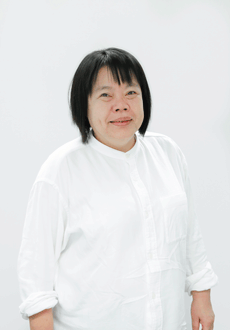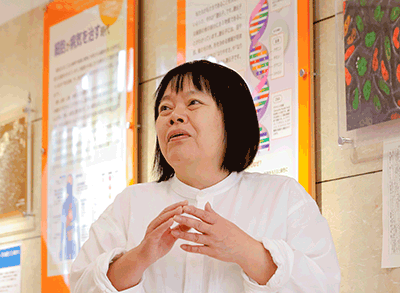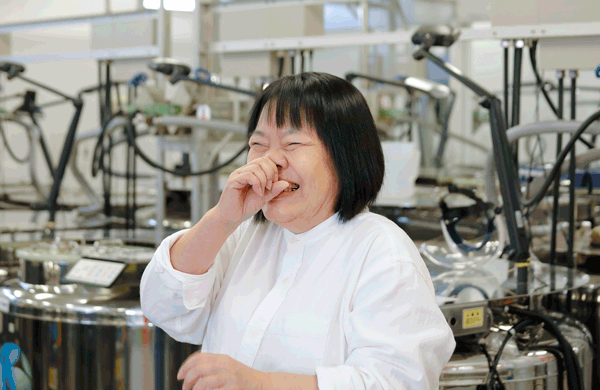Helped to launch the bioresources bank project and working to reform the mindset of researchers (Kaoru Saijo, Special Temporary Technical Scientist)

Many women active in a variety of fields work at RIKEN BRC. We interviewed 12 of these women for their insights on how they continue to flourish with work styles that fit their particular lifestyles.
In this interview, we talked with Kaoru Saijo, who works as a Special Temporary Technical Scientist in the Cell Engineering Division (RIKEN BRC Cell Bank). She had intended to become a science teacher, but she entered the world of research in the wake of her graduation thesis research at RIKEN.
Saijo has been here for more than 30 years now, building up many accomplishments, including launching the BioResource Research Center Cell Bank. She spoke to us about her thoughts on work, motivation, and hopes for the future, among other topics.
Profile
- Kaoru Saijo
- Special Temporary Technical Scientist, Cell Engineering Division (RIKEN BRC Cell Bank)
- In 1985, Saijo joined RIKEN as a subcontractor. In 1991, she officially became a RIKEN employee as a technical scientist, and has continued to participate actively at RIKEN. She was also involved in the Gene Bank, the predecessor of the Bioresource Research Center, and helped to launch the BioResource Research Center Cell Bank. Currently, she is responsible for managing whole operations at the Cell Bank.
My dream was to become a high school teacher, but before I could realize it, I was on the path of a technical scientist.
Originally, I liked school subjects like math that allowed me to consolidate my own thoughts and come up with the answer. Back then, I wanted to be a teacher because I liked working with people and I was influenced by and admired my high school teacher.
However, when I was working on my graduation thesis summarizing my research on cells, I was recruited by a researcher to join RIKEN. Before I even knew it, I was in the research profession, but the process of arriving at answers whether the experiment was a success or failure fitted my personality, so I think, I was really lucky to find this job, ultimately.
I ended up taking a path different from my initial dream, but the idea of looking at things from multiple perspectives—an influential idea from the teacher who inspired me to become a teacher—is really helpful in the world of research. For example, even when an experiment leads to a single answer, I am able to step back and think again about whether this answer would really be correct from a different angle. It has enabled me to raise the accuracy of my experiment results.
In addition, once I built up my experience, other people from both within and outside RIKEN consulted me about cell culturing. It makes me so happy to hear that my advice helped their experiments go well, and it also seems like my desire to become a teacher has been satisfied in this way.
Contributed to the launch of the bioresources bank project. Working to change the mindset of researchers.

It is probably hard to imagine now, but until the late 1980s, we generally obtained bioresources from neighboring laboratories. We’d just ask, “Do you have cells? Can I have some?” If they were available nearby, we obtained and cultured them, and if someone else wanted bioresources, we’d share them, too.
Quality management was so lax and we were just passing bioresources among each other, so often the qualities of the cells have changed in the middle, or the wrong cells have been exchanged. In order to prevent such troubles, in 1985, the “Gene Bank ” was newly established to conduct bioresources banking.
When it was launched, the hardest part was making everyone understand the need for the bank. It makes sense that people would ask why they had to go through the Gene Bank and pay to get bioresources, in spite of being able to obtain cells for free before.
Also, most people had doubts about the “deposit” of cells from researchers, and wondered whether these cells would simply be passed out to people without authorization if the Gene Bank had charge of them. To all of this controversy, I had to patiently continue to preach the importance of conducting research with the right cells and the process for the deposit and distribution of bioresources, until finally we gradually earned trust and the bank’s work was recognized.
In 2001, the current BioResource Research Center was established, and is used with confidence by many researchers. When it was first launched, there were many things we didn’t understand and we just went through a process of trial and error, but I am proud that I played a part in facilitating research.
The research profession has positions that allow women to participate actively, and I want to tell everyone that there are many ways of giving it a shot.
Many high school students attend a tour RIKEN BRC, and some female students often ask me how they can get a job here. Many people seem to have the idea that you cannot do research work unless you are a researcher, but there are positions other than researcher, such as “technical staff,” someone who supports researchers.
Women are generally considered suited to suit jobs, such as involving precision or raising something like cells and mice, and, many women work as technical staff at RIKEN BRC. Anyone who likes experiments and wants to work in the sciences should definitely consider this way of trying it them out.
I have reached retirement age in 2020, and have been currently working as a Special Temporary Technical Scientist, but the duration of such temporary assignments is set at five years. I think of this time as my opportunity to raise the next generation, and am working on passing on my roles to others. I want to pass the baton in terms of both the techniques I’ve learned and my passion.
After my temporary assignment ends, I am planning to travel to see World Heritage sites and Natural World Heritage sites. While staying true to my personal motto of “both emotional and physical health,” I plan to enjoy the rest of my research life and the rest of my life.
